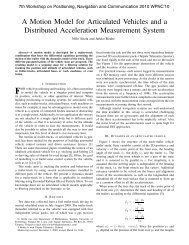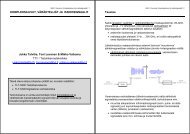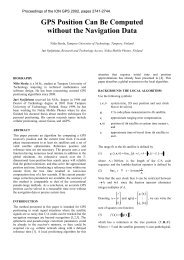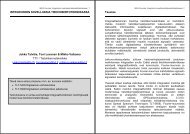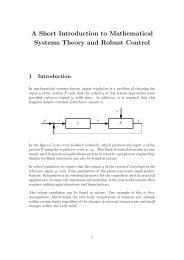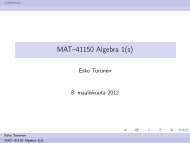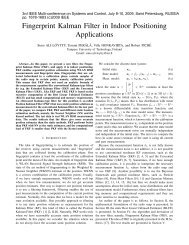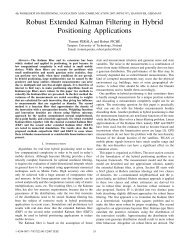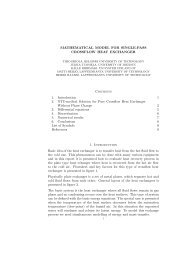Antti Lehtinen Doppler Positioning with GPS - Matematiikan laitos
Antti Lehtinen Doppler Positioning with GPS - Matematiikan laitos
Antti Lehtinen Doppler Positioning with GPS - Matematiikan laitos
You also want an ePaper? Increase the reach of your titles
YUMPU automatically turns print PDFs into web optimized ePapers that Google loves.
us approximate the delta range residuals function p(ˆx) by the first order Taylor<br />
series at the estimated point xk:<br />
p(xk + △x) ≈ p(xk)+ ∂p(ˆx)<br />
<br />
<br />
△x (4.18)<br />
∂ ˆx<br />
where △x is a vector whose norm is relatively small.<br />
ˆx=xk<br />
For simplicity, we will use the followingnotation for the derivative matrix:<br />
G(xk) ≡ ∂p(ˆx)<br />
<br />
<br />
<br />
∂ ˆx<br />
ˆx=xk<br />
Now the approximate solution for the equation p(xk + △x) =0 can be found by<br />
settingthe right hand side of the approximate equation 4.18 to zero and solving<br />
for △x. Thus△x needs to be solved from the equation<br />
p(xk)+G(xk)△x = 0 (4.19)<br />
Assumingthat measurements from four satellites are used in the calculations<br />
(p(ˆx) ∈ R 4 ) and that the derivative matrix G(xk) is nonsingular, we obtain the<br />
equation<br />
△x = −[G(xk)] −1 p(xk) (4.20)<br />
where △x = xk+1 − xk is the difference between the new and the old estimated<br />
position and drift vector.<br />
4.5.3 The Gauss-Newton Method<br />
It is not very practical to limit oneself to use only four satellites in the positioning.<br />
There is always some noise present in the delta range measurements ˙ρi. Consequently,<br />
it is usually unwise to discard any available data. The Newton method<br />
can be slightly modified so that it can be used for any number of satellites. We<br />
want to use the equation 4.17 we have derived. Now when we may have more<br />
than four satellites it is highly probable that the delta range residuals function<br />
p(ˆx) does not have a zero. Instead, we now seek the point for which p(ˆx) is<br />
closest to the zero point in the Euclidean norm sense.<br />
The problem of the equation 4.17 is first reformulated as a nonlinear least squares<br />
problem:<br />
min p(ˆx) 2 : ˆx ∈ R 4<br />
(4.21)<br />
It is easy to see that when the number of satellites n = 4, the equations 4.17<br />
and 4.21 produce the same result ˆx. The difference is that the latter can be<br />
used always when n ≥ 4. When the equation 4.21 is solved by the Gauss-Newton<br />
26




